Tillandsia retrorsa
Click thumbnails for full size, scaled to a new window.
Tillandsia retrorsa
By the BSI Taxon List, retrorsa has been synonymized with streptocarpa.
See notes below, pressing for retrorsa to be more widely accepted as a species not in synonymy.
T. retrorsa habitat photo from Derek Butcher. "Tillandsia retrorsa Coleta PE Rio Preto - S. Gongalo do Rio Preto - MG"
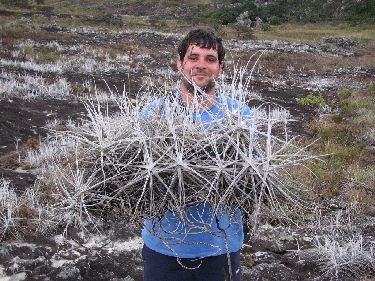
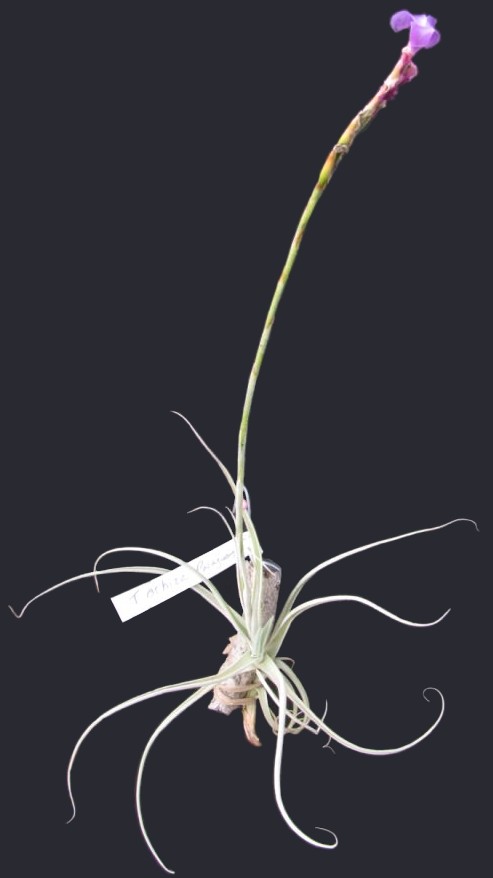

| *T. retrorsa Coleta PE Rio Preto - S. Gongalo do Rio Preto - MG |
John Olsen 12/13 |
Derek Butcher 11/18 as 'Breweri' / arhiza |
*T. retrorsa habitat photo from Derek Butcher. "Tillandsia retrorsa Coleta PE Rio Preto - S. Gongalo do Rio Preto - MG"
Derek Butcher 12/13 ... "For several years now we have had at least two forms of the T. streptocarpa complex that have been called Tillandsia arhiza.
The true T. arhiza is a small plant from Paraguay and is rare in Australian collections but is filtering in via Germany.
About 20 years ago Daniel Brewer and Paul Isley found a T. streptocarpa in Minas Gerais in Brazil.
It looked like a large T. arhiza and Harry Luther decided it was T. arhiza not T. streptocarpa.
In the intervening 20 years no plant has been reported as a link from the endemic T. arhiza in Paraguay.
In 1931 there was a T. retrorsa Silveira that was collected in Minas Gerais and its description is a much better fit than that of T. arhiza.
I have convinced Eric Gouda that we are better served calling the plant from Minas Gerais T. retrorsa than a questionable T. arhiza.
So if you have this plant from the USA I suggest you change the name to T. retrorsa. If you have it under the old name 'Breweri' all to the good.
From now onwards you will find detail of this American identification under T. retrorsa on the DVD.
I always try to make things simple!"
Mark Supple 12/13 ... "Derek, so the T. arhiza I got from you is in fact T. retrorsa then? Just asking as it is not what I call a small plant."
Derek Butcher 12/13 ... "You have it in one Mark. This plant came from Harry Luther and I had been arguing with him ever since!!
In other words T. retrorsa is closer to T. streptocarpa sensu L B Smith than it is to T. arhiza sensu Luther"
John Olsen 12/13 ... "I have a small plant from Peter Tristram labelled T. arhiza Paraguay which is flowering. (As attached.) Flowers are smaller than my streptocarpa varieties."
Derek Butcher 11/18 ... "I am having problems in convincing Eric that T. retrorsa should be accepted at species level until something is decided where it fits properly. At the moment I intend sending the enclosed to various Aussie editors." Ed. see picture above and details (2018) below.


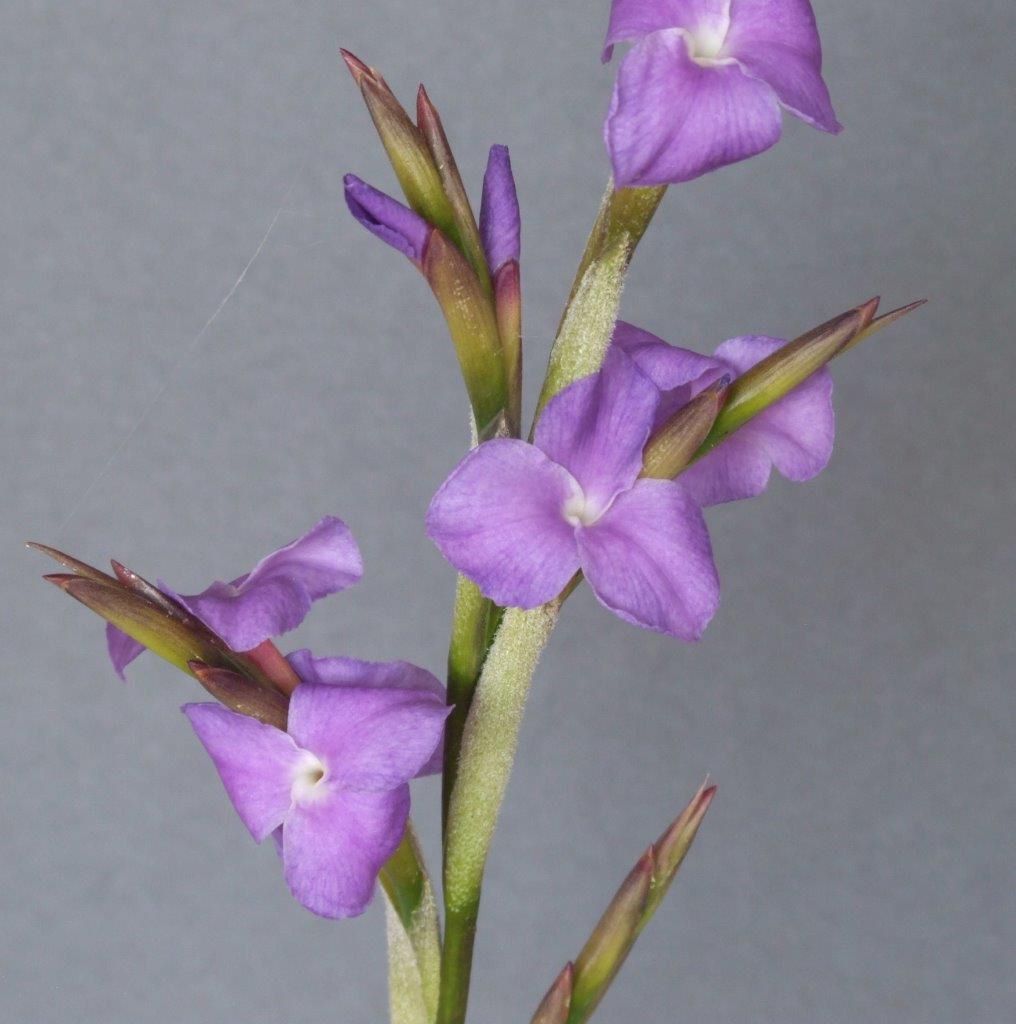
Rob Bower ... "It seems that Peter Tristram calls this a form of streptocarpa and Harry Luther called it a synonym of arhiza. Maybe I'll stick with retrorsa until someone makes up their mind?"
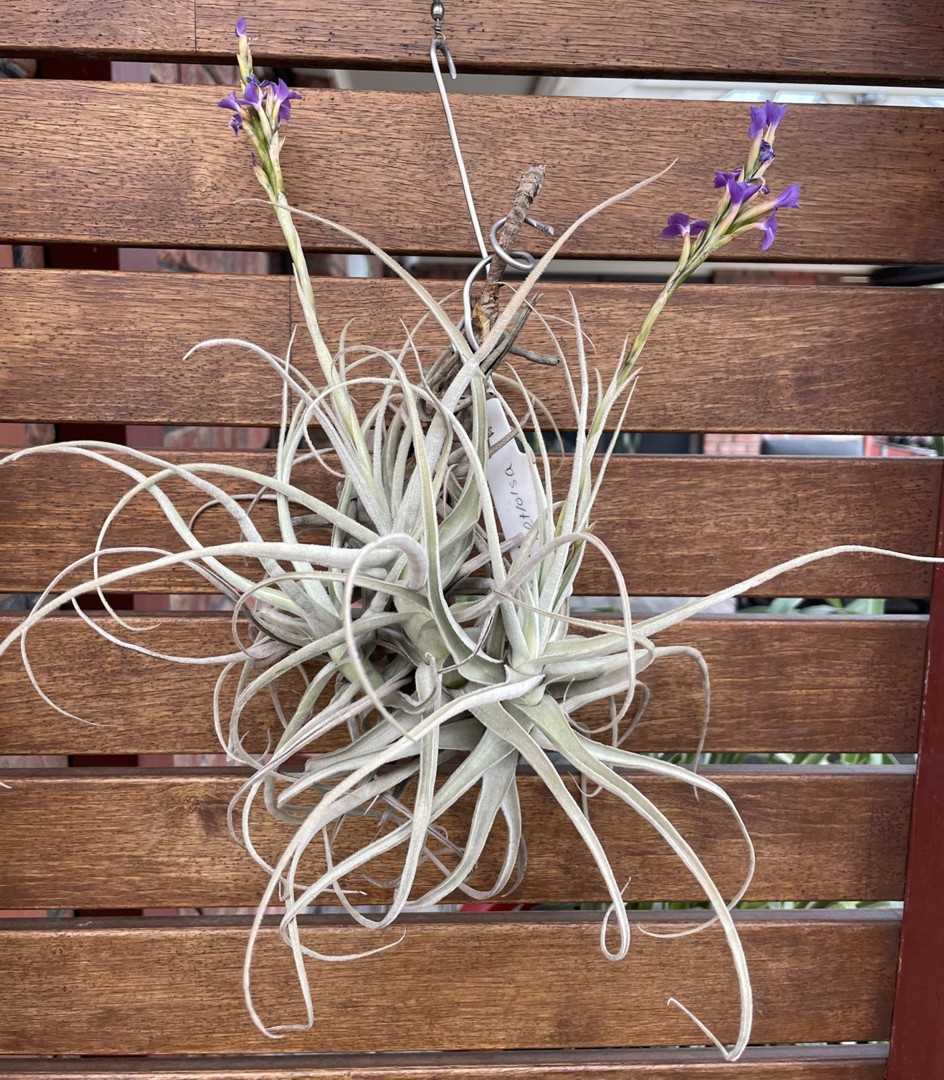
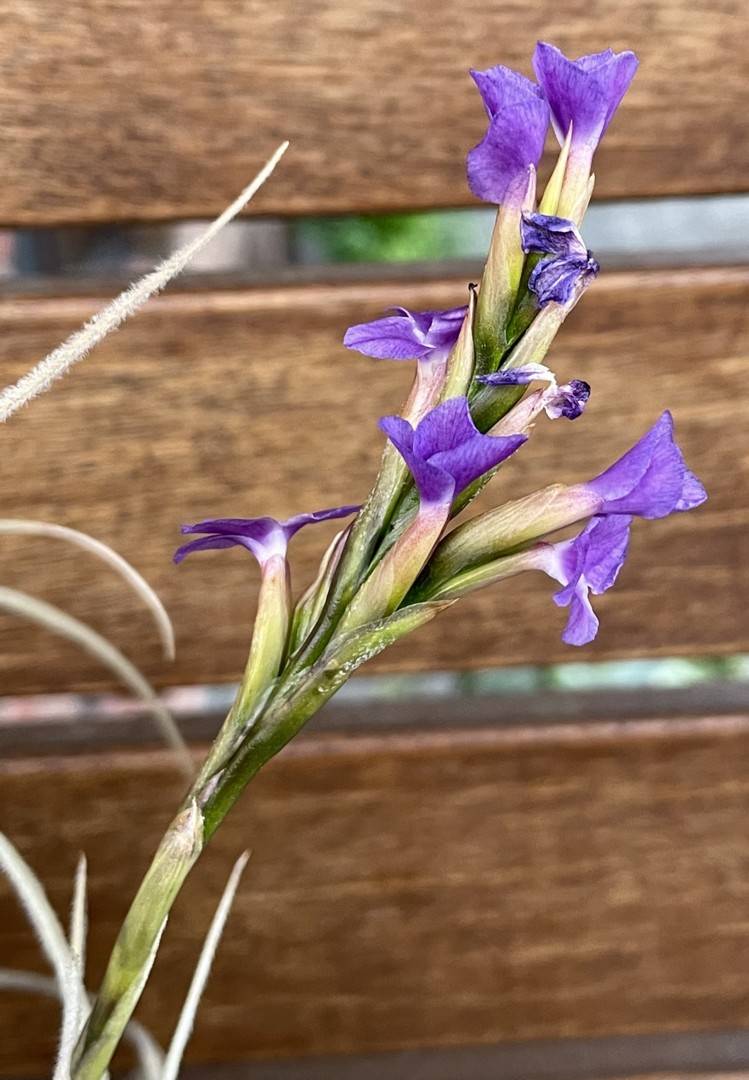

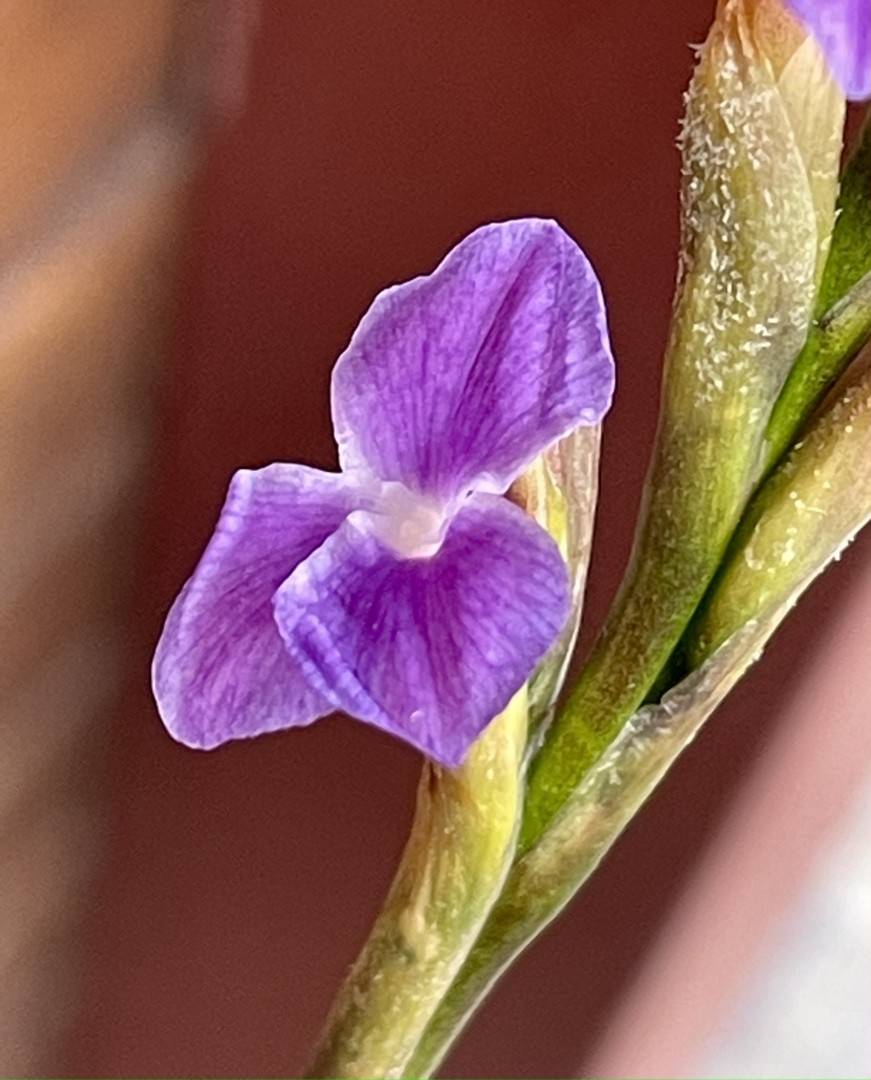 Ray Clark ... "Is anyone else growing this plant?"
Ray Clark ... "Is anyone else growing this plant?"
George Nieuwenhoven ... "Yes I have a strong plant supplied by Chris Larson, it looks like a giant paleacea."
Ray Clark ... "George thanks, they are bigger than ‘normal’ streptocarpa to my eye too."
George Nieuwenhoven ... "Yep the first thing that you notice that it’s a robust form of it."
Bruce Dunstan ... "I have a couple of clones. One much larger. I'll have to take some pics one day to compare. Both came from Peter Tristram."
Ray Clark ... "Peter Tristram , given the provenance of my plant, Derek ex Renate, should I be sticking with the retrorsa name? Or revert to streptocarpa (retrorsa)."
Peter Tristram ... "IMO the only Australian plants that should have retrorsa on the label should also have RFI or BRT on the label and/or were imported as arhiza, breweri or kurt-horstii, long ago.
They all came from rocky outcrops in MG Brazil. In 2012 I discussed the plant again with Paul Isley, at his nursery, and he gave me a few to bring back. It seems Brazil is full of streptocarpa/paleacea complex species though most still remain lumped. The ones we call retrorsa are very distinctive and deserve attention but who in botanical game would tackle it? Harry didn’t have arhiza specimens from Paraguay when the earlier discussions were happening so as to compare (so some material in the trade in the US was misnamed) and nor did any of us until I got a variety of clones from Lotte, Uwe and some eastern German BGs on my travels. They are totally different! The 2012 imports are identical to the old imports, as expected, and identical in appearance to the plants pictured on facebook by a Brazilian whose name escapes me. Like Derek, I could write a lot about these plants and sure agree re the can of worms. They are all such amazing species and I do hope for some delineation in the future."
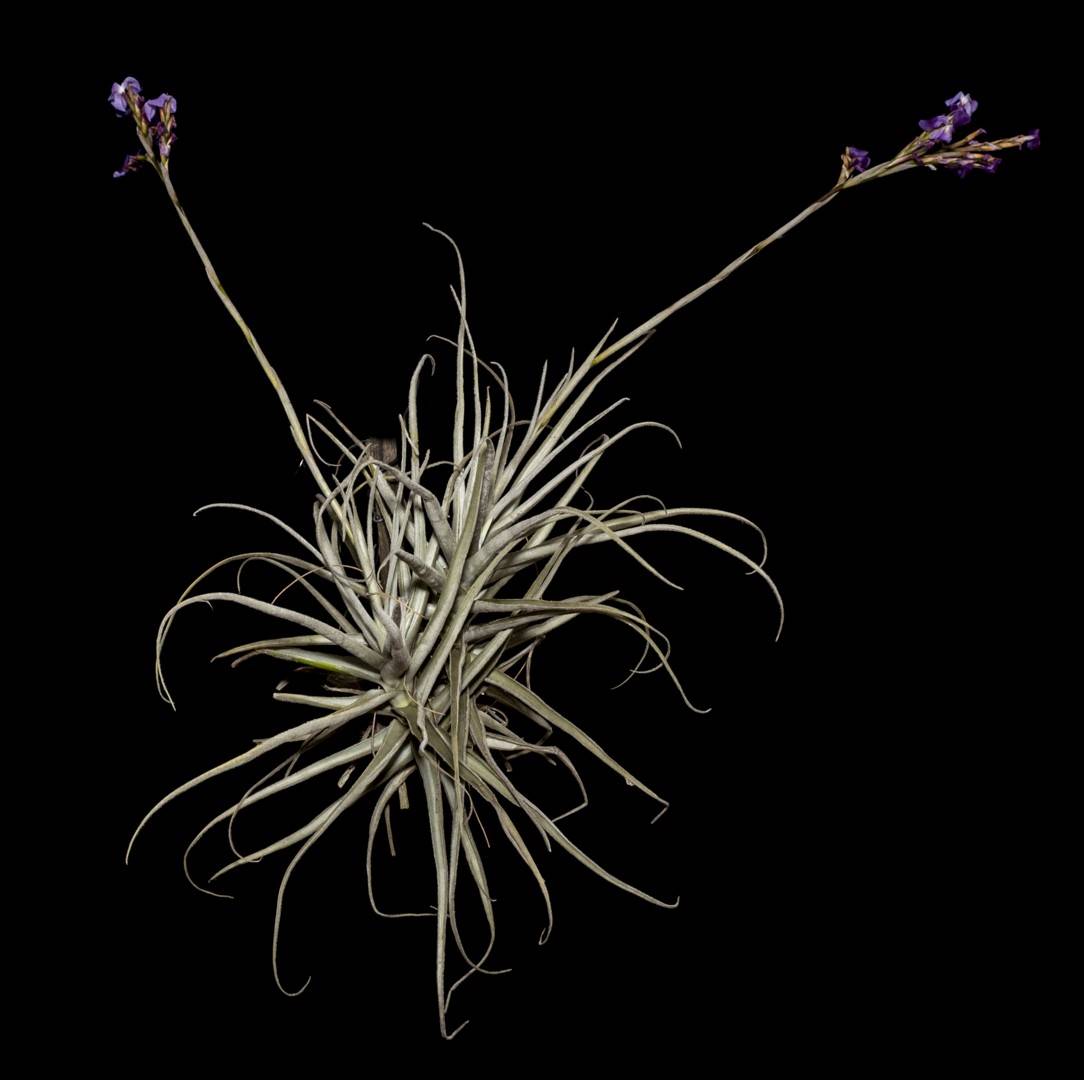
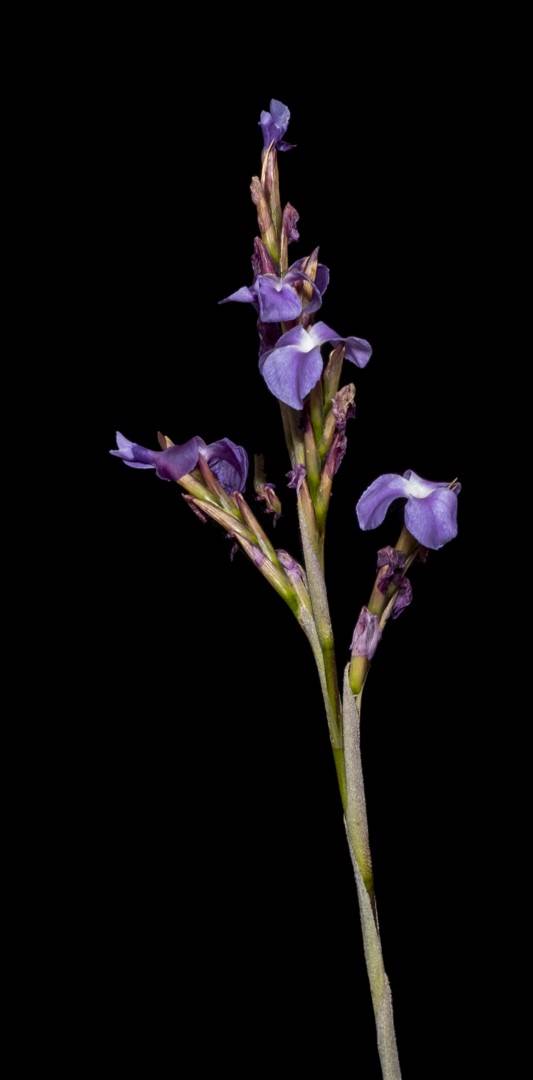

| Rob Bower 11/22, same plant as shown 2 years ago above. |
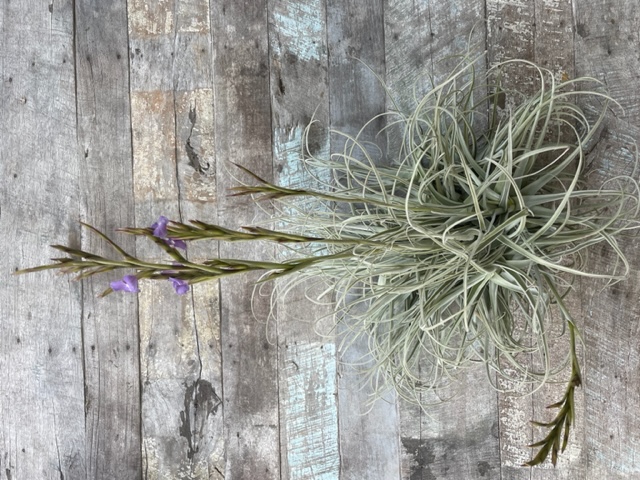
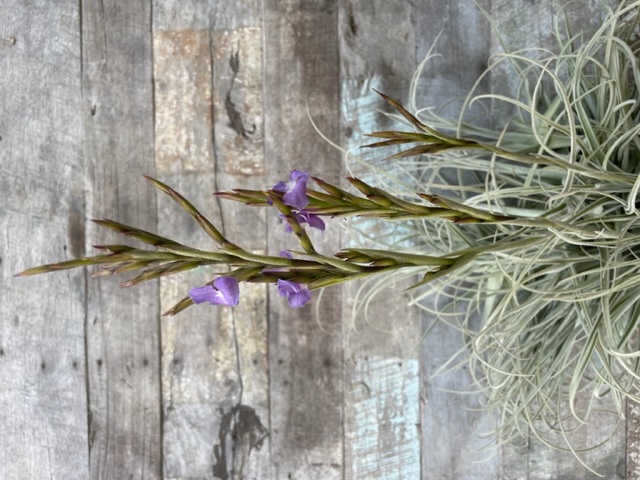
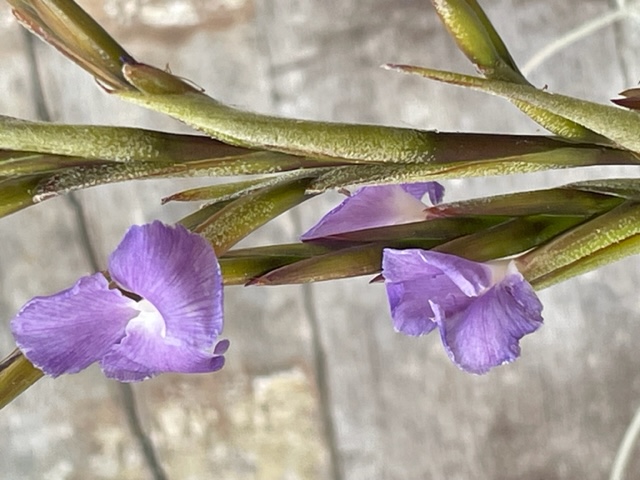
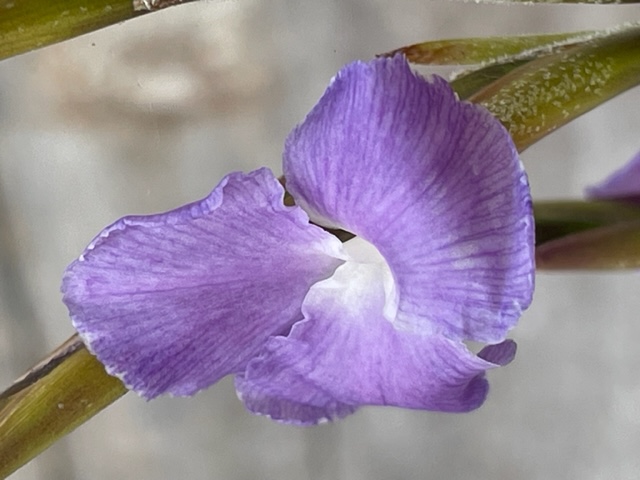
| Bruce Dunstan 12/22, as retrorsa |
Rob Bower ... "When I posted the last pics nearly 2 years ago, I got some comments that the name was under review – I guess they made up their minds. Thanks for the info on new names. My tillandsia collection is shrinking with all the revisions !"
Peter Tristram ... "In my opinion keep the name but add 'streptocarpa' to the label. These plants came from Brazil mainly via RFI and deserve to be looked at again. T. retrorsa was confused with arhiza too with much discussion. T. arhiza is now lumped but was also confused with graomogulensis. Some collections still have these names. Synonyms abound! A relook at the 'retrorsa' population may well be happening with the Brazilians like Sousa and others like Liesotte Hromadnik describing new Brazilian species these days. It wouldn't surprise me if retrorsa is resurrected, especially if that is the same species originally described from the particular habitat location where our plants were collected. Look through the mountain of files on streptocarpa if you want a challenge. Die Bromelie has more as well. Add in paleacea for fun and the accepted split off species like graomogulensis, kirschnekii and the recent santiagoensis to name a few, as well.
As Graeme said, the BSD has the most up to date info! Fantastic resource."
Rob Bower ... "Thanks – I'll keep retrorsa for a while and also graomogulensis and arhiza. Do you know how they approach the question of when to clump and when to split? Is it DNA-based? I have a few friends who are taxonomists and theyre a weird breed."
Peter Tristram ... "Derek Butcher introduced me to the terms, lumping and splitting, ages ago. Some taxonomists were inclined to lump similar plants from various populations, others liked to describe a separate population as a separate species. The Germans were good splitters, the Americans generally lumpers. Just look at the lists of synonyms as a broad indication of the history of these processes. DNA analysis is often confusing the plot even more!"
"Tillandsia breweri" by Derek Butcher in J Brom Soc 46(6): 247-249. 1996
This could be called "the plant that never was", because this is the name in use in Australia for a plant imported from Rainforest Flora in Los Angeles to Melbourne in 1992. Apparently the plant had been collected by Daniel Brewer and Paul Isley in Minas Gerais, Brazil.
The Melbourne plant is owned by Brenton Cadd and recently flowered. It was a topic of discussion on the Internet during May, 1996. Parts of the plant were sent to me in a "herbarium" state. I found dissecting it to be a new challenge because I usually work with live material. I can now understand why so many of the old descriptions are vague about stamens and stigmas because these fall to pieces very easily. However, I did have coloured photographs to help me with my work sheet.
The key in Smith and Downs shows that Tillandsia arhiza (as well as T. paleacea) has a long stem with leaves mostly shorter than the stem, whereas T. streptocarpa has leaves much longer than the stem.
Remember that Smith and Downs also suggests that T. streptocarpa and T. paleacea are conspecific which clouds the "key" difference even more.
Comparing the written descriptions of T. arhiza and T. streptocarpa I found only a few minor differences:
| - | T. arhiza | T. streptocarpa |
| Stem | to 60 cm long | to 10 cm long |
| Leaves | shorter than stem | longer than stem |
| Blades | 7-9mm wide, 20cm long | to 15mm wide, 8-50cm long |
| Scape | glabrous | nearly glabrous |
| Scape bracts | tubular involute, sublanceolate | lanceolate |
| Inflorescence | mostly simple | rarely simple |
| Pedicel | short & stout | ?? |
| Sepals | connate, 3mm | free to very short connate |
Comparing my worksheet with both descriptions, "T. breweri" seems closer to T. streptocarpa than to T. arhiza.
From a horticultural perspective one outstanding feature was not mentioned in either description. While the leaf sheaths completely enclose the stem, the leaf blades diverge sharply at 90 degrees, almost like rungs on a central pole ladder.
Could this have been caused by growing the plant erect rather than allowing it to sprawl as it would likely do on rocks in its habitat?
T. streptocarpa is very widespread, having been reported from Peru, Bolivia, Brazil and Paraguay, and comes in many forms, whereas T. arhiza seems to be endemic to a small area in Paraguay. There should therefore be strong suspicions that any plant found in Brazil might be T. streptocarpa.
Investigation into the naming of this plant brings the following questions to my mind:
1. Why hasn't T. streptocarpa been made a synonym of T. paleacea as suggested by Smith & Downs over 15 years ago?
2. If this had happened then the amended description would make it very difficult for T. arhiza to stand alone. However, it would be just as difficult not to ignore T. kirschnekii, T. kurt-hortstii, T. reichenbachii, and T. duratii. This whole problem is just waiting to be solved by some doctorate dissertation.
3. A small step in the logical approach was made by Till when he described T. paleacea subspecies apurimacensis in J. Brom. Soc.43(l):7-10. 1993 but this could just as easily have been called T. streptocarpa ssp. apurimacensis - an intriguing situation to the non-botanist.
4. Where do most of the T. arhiza plants in cultivation come from? Is it Paraguay, Brazil or even Bolivia where Lotte Hromradnick reports plants having been found near Rio Chico?
In July 1996 on my trip to the world conference in Orlando my bag was full of questions and "T. breweri" was discussed with Harry Luther. Apparently most of the plants called "T. breweri" are in U.S. collections as T. arhiza, which runs counter to my Australian findings. I also found out that T. streptocarpa prefers being an epiphyte and is fragrant whereas T. arhiza is a lithophyte and is not fragrant. This allayed my curiosity for a while.
However, in a seminar on Brazil presented at the same conference, a slide was shown depicting T. streptocarpa growing on rocks! To jump up and query the situation would have been embarrassing, even to an Australian, so I sat and pondered.
Why am I telling you all this? I always enjoy trying to unravel problems and sometimes succeed, but felt I just had to share the saga of the plant that never was.
Tillandsia ‘Breweri’ / arhiza revisited By D Butcher 1/2008
The Tillandsia arhiza I got from Harry Luther in 1996 has flowered again. The delay may have been because I nearly lost the plant due to mealie bugs! To digress. If you do have a Tillandsia where the leaf sheaths really encircle the stem beware mealie bug. Their presence can be detected by ant activity!
I have many more details of old descriptions than I had in 1996 and after some years of experience as cultivar Registrar I now realise I should have pushed for the acceptance of ‘Brewer’ as a cultivar name. (see J. Brom Soc. 46(6): 247-9. 1996). I wonder if this plant is still alive in Australia and if Brenton Cadd is still growing it, and under what name! The plant called Tillandsia breweri was apparently collected by Daniel Brewer and Paul Isley in Minas Gerais, Brazil and I had a strong feeling that the plant I got from Harry had been originally received from Paul Isley!
Lyman Smith treated T. streptocarpa as a widely dispersed species from Peru, Bolivia, Paraguay, and Brazil, where the plants were short caulescent with leaves much longer than stem, whereas T. arhiza comes from Paraguay and is long caulescent with leaves mostly shorter than the stem.
In 1987 Werner Rauh described T. kurt-horstii and in 1999 Walter Till considered it was identical to T. graomogulensis ( a misspelling of T. graomogolensis in Smith & Downs) which had been treated as a synonym of T. streptocarpa by Lyman Smith. Because T. graomogolensis A Silveira, had been published earlier then that name prevailed. So, here we have a synonym successfully removed from Lyman Smith’s concept of T. streptocarpa.
In 1931 A Silveira also described T. retrorsa and my translation follows:
Tillandsia retrorsa A Silveira, Floralia Montium, 2: 25. 1931
Treated by S&D as a synonym of T. streptocarpa but treated by Luther as a synonym of T. arhiza even though this seems only endemic to Paraguay
Root fibres dark brown in new specimens, when adult often none.
Stem ascending, the upper part erect, simple or branched, clustering, forming more or less extensive colonies, about 5-8mm thick, up to 50cm long.
Leaves triangular at the base almost enclosing the stem and very long subulate, spreading at almost 90º, above concave channelled, both sides dense lepidote, in the lower part the lepidotes are long ligulate, the lower ones are without a point or ligulate, the ligules below are recurved pointing backwards, above appressed, 2cm wide at base, 1cm wide at the middle, 25-30cm long.
Inflorescence many flowered, made of a panicle with branches often with 3-4 distinct bracts, the sheaths of the bracts totally enclose the scape, lanceolate at the base, the upper part long linear-subulate, pale green, the outside lepidote, decreasing in length to the top.
Floral bracts ovate, acute.
Flowers not seen.
Capsule cylindric, acute, 3cm long.
Seed fusiform, many, brown, the tip caudate, tails 2mm long, at the base silky white hairy nipple-like coma to 20mm long.
Habitat in a flat, sandy, rocky area in Serra Geral, between Diamantina and Serra, very frequently in extensive colonies scattered on quartzite rocks, July 1926; no. 794 in Silveira Herbarium
Differs from T. streptocarpa mainly in :
Long stem.
Size of lepidotes on leaves and others.
The length of stem of this plant does not sit comfortably under T. streptocarpa sensu Lyman Smith and in Harry Luther’s opinion should be synonymous with T. arhiza. However he has not published his reasonings on this or to expand the habitat area, for it to be subject to peer review.
Clearly ‘Breweri’ and the plant I got from Harry have greater links to T. retrorsa than to T. arhiza sensu Smith. As such I will be putting T. aff. retrorsa on the label of my plant which, by the way, has a strong scent like T. duratii according to the chief scenter of the Butcher family. As I pointed out in my 1996 article Walter Till was of the opinion that T. arhiza was not scented
I do not intend going to print on this subject, leaving that to the academic taxonomists, but felt you should know a bit of this history.
Tillandsia retrorsa Silveira– To split or lump by Derek Butcher Nov 2018
At the current time this is treated as a synonym of T. streptocarpa in the New Bromeliad Taxon list, as a synonym of T. arhiza in the World Checklist (WCSP) and a species in its own right in REFLORA ( run by the Brazilians).
The Tillandsia specialist Group in Australia follow the Brazilians.
Lyman Smith treated T. retrorsa as a synonym of T. streptocarpa but links T. arhiza with T. paleacea. He also linked T. paleacea with T. streptocarpa.
This all started in the 1980’s when Daniel Brewer and Paul Isley were collecting in South America. When in Minas Gerais, Brazil they collected a plant that looked like a T. streptocarpa but which Harry Luther identified as T. arhiza which comes from Paraguay. No attempt seems to have been made to link it to T. retrorsa from Serra Geral, between Diamantina and Serra. In 1992 this T. arhiza arrived in Melbourne at Garden World from Rainforest flora. In 1996 I got my plant direct from Harry Luther and because I knew its history it got the nickname of ‘Breweri’ and it did not look like a typical T. arhiza that had been collected in Paraguay by the Germans. May I mention here that T. streptocarpa is also found in Paraguay!
What I find intriguing is another plant from Minas Gerais, T. grao-mogolensis Silveira, was promoted from Smith’s synonymy under T. streptocarpa to species status by Walter Till to accommodate T. kurt-horstii Rauh as a synonym. The same sort of time frame but different conclusions!
So we await a scientific paper, possibly as a doctoral thesis based on DNA studies as to what constitutes the T. streptocarpa complex.
My translation of the original description
Tillandsia retrorsa A Silveira, Floralia Montium, 2: 25. 1931
Root fibres dark brown in new specimens, when adult often none.
Stem ascending, the upper part erect, simple or branched, clustering, forming more or less extensive colonies, about 5-8mm thick, up to 50cm long..
Leaves triangular at the base almost enclosing the stem and very long subulate, spreading at almost 90º, above concave channelled, both sides dense lepidote, in the lower part the lepidotes are long ligulate, the lower ones are without a point or ligulate, the ligules below are recurved pointing backwards, above appressed, 2cm wide at base, 1cm wide at the middle, 25-30cm long.
Inflorescence many flowered, made of a panicle with branches often with 3-4 distinct bracts, the sheaths of the bracts totally enclose the scape, lanceolate at the base, the upper part long linear-subulate, pale green, the outside lepidote, decreasing in length to the top.
Floral bracts ovate, acute.
Flowers not seen.
Capsule cylindric, acute, 3cm long.
Seed fusiform, many, brown, the tip caudate, tails 2mm long, at the base silky white hairy nipple-like coma to 20mm long.
Habitat in a flat, sandy, rocky area in Serra Geral, between Diamantina and Serra, very frequently in extensive colonies scattered on quartzite rocks, July 1926; no. 794 in Silveira Herbarium
Differs from T. streptocarpa mainly in - Long stem, Size of lepidotes on leaves and others.
Updated 09/01/23



















